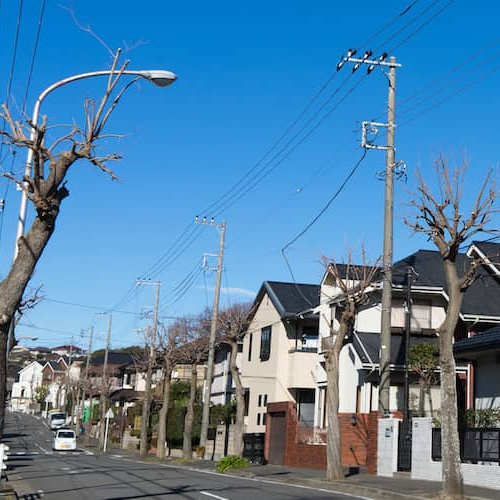Buying a house with well water and how it works
Jul 16, 2025
•8-minute read

When buying a house, it’s helpful to know some basic details about its systems, including where the water comes from. In some homes, running water comes through a well system that pumps it into the home from underground.
This guide explores what to know about buying a house with well water.
What is well water?
As it rains, water soaks into the ground and filters downward until it reaches a dense layer of rock. The water sitting above dense rock is considered an aquifer or groundwater. When a home uses well water, a pump system taps into this underground water resource to supply running water to the property.
Typically, you’ll find homes running on well water in rural areas and waterfront locations. Over 20 million homes rely on well water nationwide.
When living in a home with well water, it’s the homeowner’s responsibility to monitor and verify the safety of the water. Well water is naturally filtered through the ground before it’s pumped into your home. This natural filtration system tends to leave the water with a higher mineral content than municipal water. However, it’s essential to independently test the water to confirm that it poses no health risks.
How does well water work in a house?
Well water travels from beneath the ground – as far down as 1,000 feet – in a well casing. A pump pushes the water up into a pressure tank, where it is stored until you use it in your home.
Some systems may include a water softener, which removes some minerals from the water. This reduces wear and tear on your appliances and makes the water gentler on your skin.
Considerations when buying a house with well water
Before jumping into buying a home with well water systems, it’s helpful to consider all the details. Explore what you need to know below.
FHA and VA loan requirements for well water
When it comes to financing your home purchase, a home with well water can come with some different hurdles to clear for certain loan types.
Private wells don’t come with testing requirements, which means the property owner is responsible for the quality of the water. In contrast, water from public shared wells is typically treated and tested extensively before it arrives at your faucet.
For government-backed loans, including Federal Housing Administration, U.S. Department of Agriculture, and Veterans Affairs loans, the lender may require additional testing before approving a home purchase with well water or cisterns.
Typically, the tests look for harmful contaminants in the water. Common contaminants include bacteria. But the key contaminants to look for can vary across the country. For example, in an agriculturally intensive area, homeowners may want to test the water for fertilizers.
Conventional home loans may or may not require testing of well water to approve a home purchase. The requirements for testing vary from lender to lender.
Wells require ongoing maintenance
Once you obtain financing for a home with well water, your responsibility doesn’t end there. Instead, you’ll need to regularly maintain and repair the well to ensure your water quality continues to meet your standards.
Some common well maintenance suggestions include:
- Periodic water testing. It’s a good idea to annually test your well water to confirm it’s free of contaminants. Expect to pay between $25 and $400 for a water test.
- Filter replacements and upgrades. On top of the pump, you may decide to add a filter or other upgrades, which can increase the maintenance costs. Filtration systems cost between $1,000 and $5,000.
- Energy cost. Well pumps require energy to efficiently pull water into the house. While costs vary based on your specific situation, the average monthly cost to run a well pump is about $65.
- Pump servicing. Like all machines, well pumps require regular servicing. Expect to spend between $350 and $1,600 on servicing a broken pump.
- Noncompliance fees. Depending on where you live, you might face significant noncompliance fees when your well water fails to meet local standards. Enforcement of these fines could cost thousands of dollars per day.
Well water is subject to local regulations
Although the homeowner is responsible for the well water’s quality, local governments also regulate well water. Local regulations typically require well water to meet specific quality standards. If you don’t comply, the city may fine you.
The regulations vary from city to city. But you can usually uncover the relevant regulations through a quick call to your local government.
Septic tanks can contaminate well water
Septic systems treat wastewater from your home in an underground tank on your property. If a septic system fails, sewage could leak into the groundwater and contaminate your well water.
If buying a home with a septic system and well water system, install your well at least 50 feet from any septic tanks and septic leach fields. Regardless of the septic system’s proximity to your well, it’s critical to regularly maintain your septic system to avoid failures.
Maintaining a house with well water: 5 tips
With city or tap water, the local water authority oversees many of these steps. When you have your own well, you’ll need to do some work to ensure your water is of the highest quality.
1. Test your well water annually
You’ll need to test your well water for various elements, depending on your location and any potential issues in the area. At a minimum, your well should be tested every spring for harmful bacteria, dissolved solids, and nitrates. The pH level also should be monitored.
You can buy testing kits to analyze water quality yourself. Be sure the kit tests for bacteria, nitrates, and fertilizer. Also, get kits that can test for contaminants like copper, lead, and pesticides.
If you notice any changes to your water quality, it could warrant further inspection.
It is always helpful to contact your state or local health department to learn about any potential problems with well water in the area. They can alert you to things these kits won’t pick up, like parasites.
If you suspect there’s a bigger problem, you may have to submit a sample to a lab for more in-depth water testing.
2. Get your system inspected every year
Wells need to be inspected annually for cleanliness, mechanical issues, and contaminants. To schedule an inspection, you can locate a certified contractor through the contractor listings provided by National Groundwater Association’s Wellowner.org.
Another option is to ask your neighbors who inspects their wells.
3. Observe your water softener
A water softener filters out calcium and magnesium from “hard” water. Hard water can cause buildup on pipes and in sinks, and it is rough on your skin.
If you notice hard water stains, you may need to recharge your water softener with fresh sodium.
4. Prevent hard water stains
Even with a water softener, it’s possible to get hard water stains. That’s because after the water evaporates, the high mineral content stays behind. The best way to prevent these stains is to clean them as soon as they appear.
After showering or bathing, squeegee your tub so the water doesn’t evaporate and leave a stain. If you see a stain, one of the best ways to remove it is with vinegar. Spray a mixture of 50/50 distilled water and vinegar on the stain, let it rest for 10 – 15 minutes, then rinse with distilled water and buff dry.
5. Pay attention to your drinking water
If your drinking water smells, tastes, or looks different, you should schedule an inspection right away. Many times, small changes aren’t harmful to your health but could lead to future plumbing problems.
Signs like your water turning and staying orangish-brown could indicate the presence of iron, which can cause buildup that clogs your pipes.
Likewise, a persistent rotten egg odor means elevated levels of hydrogen sulfide gas produced by bacteria. This gas can be a breeding ground for other bacteria and may produce more stains and buildup.
When you notice changes, getting the issue checked out can help you stay in front of any major water quality problems.
Pros and cons of a house with well water
When considering buying a house with well water, you should know the system’s positives and negatives. Let’s weigh the pros and cons of having a house with well water.
Pros
- No monthly water bill: Unlike city water, well water doesn’t come with a monthly bill.
- Natural, untreated water: Well water is naturally filtered without many of the chemicals involved in city water.
- Independence from the municipal supply: If the municipal water supply experiences an issue, your water may not be affected.
- Potentially better tasting water: Well water often contains minerals. For some, this can lead to more palatable water.
Cons
- Water quality concerns: Since no local government is monitoring your water quality, it’s natural to have concerns about potential contaminants.
- Up-front equipment costs: Installing a well can easily cost thousands of dollars.
- Regular maintenance and testing: To stay safe, you’ll need to regularly monitor your drinking water quality. Additionally, keeping the system working often requires ongoing maintenance.
- Hard water problems: Well water often includes minerals, which can lead to hard water issues. In many cases, hard water leaves behind residue that’s difficult to clean.
- Risk of running dry: It’s entirely possible for your well to run dry, which might require drilling a new well elsewhere on the property or finding an alternative water source.
- Property value concerns: Due to the ongoing maintenance and uncertainty of managing well water, some potential homebuyers aren’t interested in a house with well water. This could impact the property’s future value.
- Financing complications: Government-backed financing may require additional water quality testing before closing on a house with well water.
FAQ
Here are answers to common questions about houses that use well water.
How can I increase my water pressure in a house with well water?
Typically, you can increase water pressure in a house by adjusting the water pressure tank settings or installing a pump with a higher flow capacity. Consider consulting a professional to help you adjust the water pressure in your well system.
What causes no water pressure in a house that uses well water?
While it’s true that homes with well water often have lower water pressure, they don’t have zero water pressure unless there’s a problem. How much water pressure you have depends on your pressure tank and well pump. Check that the water pump has power and is functioning properly.
Should I buy a house that uses well water?
If you feel comfortable with maintaining a well and are content with where the water comes from, then buying a home that uses well water shouldn’t be a problem.
Where does well water come from?
Well water comes from underground and is drawn upward by a pump through a casing. The water flows through a pipe between the casing and a pressure tank and can then be used in your home.
The bottom line: A house with well water can work for you
Although buying a home with well water may require extra maintenance, it doesn’t have to be a deal breaker. If you are comfortable with the risks and maintenance requirements, purchasing a house with well water can be a viable option for you.
If you are ready to purchase a house, with or without well water, start the preapproval process today.

Sarah Sharkey
Sarah Sharkey is a personal finance writer who enjoys helping readers make informed financial decisions. She lives in Florida with her husband and dogs. When she's not writing, she's outside exploring the coast.
Related resources
6-minute read
Buying A House With A Septic Tank: Pros And Cons
Buying a house with a septic tank can feel intimidating, but it doesn’t have to be. Read on to learn about the pros and cons of using a home’s se...
Read more
12-minute read
How to get a loan to purchase land
Land loans are used to finance the purchase of a plot of land. However, securing this financing is different from other loans. Here’s what you should know...
Read more

3-minute read
Utility easements, explained
A utility easement is what allows public utilities like sewage, electricity, water and more to exist. Learn about how utility easements can impact homeowners.
Read more